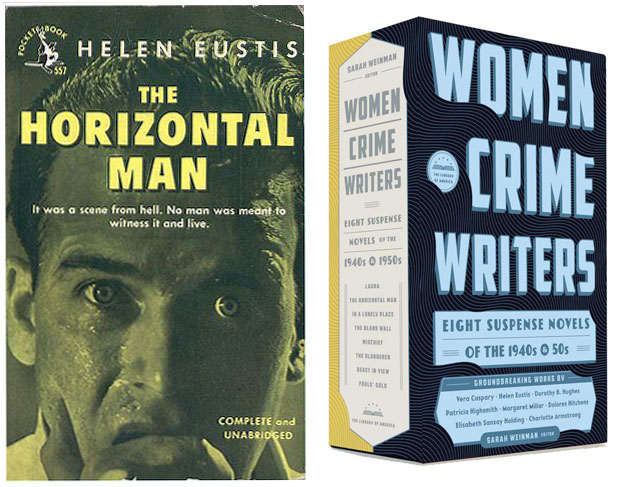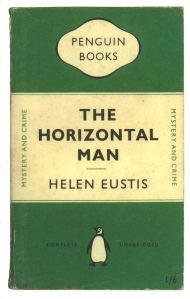 I don’t usually read noir fiction
I don’t usually read noir fiction
Too blood-curdling. Too macabre.
But I am mesmerized by Women Crime Writers: Four Suspense Novels of the 1940s, edited by Sarah Weinman (Library of America). Weinman, the editor of Troubled Daughters, Twisted Women: Stories from the Trailblazers of Domestic Suspense, has chosen four once popular but forgotten novels for this volume: Vera Caspary’s classic, Laura (which I wrote about here); Helen Eustis’s The Horizontal Man, set on a campus; Elisabeth Sansay Holding’s The Blank Wall; and Dorthy B. Hughes’s In a Lonely Place. (There is also a second volume, novels of the ’50s.)
There was so much to mull over in Caspary’s classic, Laura, that I didn’t immediately go on to the second novel, Eustis’s The Horizontal Man, winner of the Edgar for best first novel in 1946. It is superb campus noir. If you think you know campus mysteries–for instance, Edmund Crispin’s Case of the Gilded Fly, set in Oxford–you will find this very different. Set at an elite women’s college where many disturbed people thrive, Eustis’s psychological novel is simply terrifying.
Eustis’s style is not quite as smooth as Caspary’s, but her book is a very good murder mystery. Like Caspary in Laura, Eustis plays with point of view. Who would be crazy enough to murder Kevin Boyle, a handsome Irish professor of English and poet with the gift of blarney? Writing in the third person, she relates the events after the murder from the perspectives of students, professors, a reporter, the college president, and a psychiatrist.
The novel begins with a chapter of one page and four lines. Kevin is afraid but is trying his best to calm down the crazy person (unnamed) who is threatening him.
“I say,” he said, almost tenderly, “you’re not well, you know. Do let me take you home.”
But it was no use. “No!” she cried, loud and harsh–and it gave him hope that someone might hear that voice–“I’m not sick! At last I am well, at last I can tell you, Kevin! My God, do you know that is like water running down my throat to say that I love you?”
This histrionic dialogue is truly demented. The killer strikes Kevin with a poker and the chapter ends.
Then we hear from the other characters, some of whom are suspects.
 The first suspect, Molly Morrison, is an unbalanced student who had a crush on Kevin Boyle. She wonders if she could have saved him if she had simply told him , “I love you! I will black your boots, mend your clothes–anything! I love you!” That style does sound a bit like the style of the murder’s dialogue, doesn’t it? She has kept journals about her crush. She went to the malt shop regularly when he was there. And eventually she confesses to the crime, but since she is in the middle of a nervous breakdown no one quite knows what to do with this confession.
The first suspect, Molly Morrison, is an unbalanced student who had a crush on Kevin Boyle. She wonders if she could have saved him if she had simply told him , “I love you! I will black your boots, mend your clothes–anything! I love you!” That style does sound a bit like the style of the murder’s dialogue, doesn’t it? She has kept journals about her crush. She went to the malt shop regularly when he was there. And eventually she confesses to the crime, but since she is in the middle of a nervous breakdown no one quite knows what to do with this confession.
Then there is poor, weak-chinned Leonard, an English professor who lived across the hall from Kevin. He heard the thud, without realizing it was Kevin falling. He idolized Kevin, who told him stories about his many women. Leonard has had no women.
George Hungerford, another English prof, has suffered from mental illness. He is so good at his job that college president and faculty respect him and has tactfully overlooked his illness. Hungerford is haunted by an intruder who periodically breaks into his apartment and leaves a journal with details that nobody but Hungerford could know. The intruder is, he thinks, female.
Freda Cramm, yet another English professor, is seductive, buxom, and made a pass at Kevin. Suspiciously, she is caught in Kevin’s apartment a few days after his murder. She is there to retrieve a paper, she says.
At the heart of the novel are three clean-cut young people who meet in a bar.
“I gotta get an angle,” crooned the young man, rocking his face between his hands. “I simply gotta get an angle.”
That’s Jack Donnelly, the tabloid reporter. He meets two college girls, a brilliant, but plump, Kate Innes and the seductive Honey. After he prints the story about Molly’s confession (which he gets from her in an interview), Kate is furious. But after she flirts with Jack in an effort to manipulate him, the two work together solve the murder. They are the bright young innocents who save us from drowning in gloom.
This is really a very good book. I’ve never read anything quite like it. And the murderer is not who you think it is (though I did guess it before the end.) I am very enthusiastic about Weinman’s anthology of crime fiction. There’s something about women’s crime fiction. I didn’t actually know these hard-boiled women’s noir novels existed!

This sounds amazing, Kat! I bet it wouldn’t have slipped into obscurity if it had been written by a man. I really must check these titles out!
LikeLike
I know! It’s very odd. So glad Library of America is reviving these!
LikeLiked by 1 person
This sounds just like the English Faculty I used to work in!!
It also sounds extremely interesting. I am going to have to go in search of a copy.
LikeLike
The LOA Women in Crime books are available in the UK! I was surprised to see them at Waterstones. But there must also be used copies floating around of old paperbacks.
LikeLike
Another discovery thanks to you! I truly have to jot all them down or on Goodreads, and find some money to buy new books! 🙂 I did not know that women had written “noir novels” so early. I had stayed with Dorothy Sayers and Co; I am thinking of Sayers because of her own college setting for Harriet Vane and Lord Peter in “Gaudy Night”. But this seems really different.
LikeLike
Noting them on that Goodreads list is the way to go! I did find that the LOA version is available as an e-book. Very cheap!
LikeLiked by 1 person
I’ve read Laura a few times, and it was made into a movie Years ago with Vincent Price. I checked this book out at the Library. Up to In A Lonely Place right now
LikeLike
I love this anthology! I must see Laura.
LikeLike